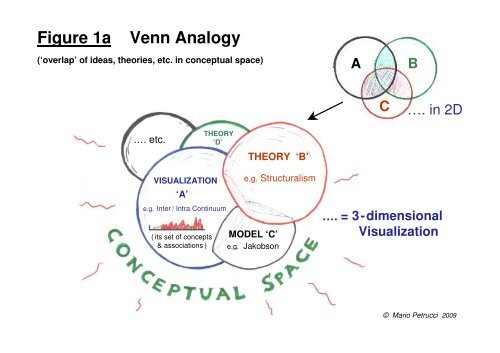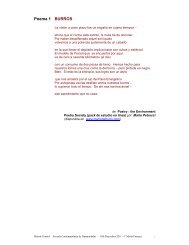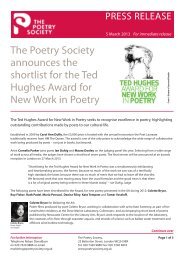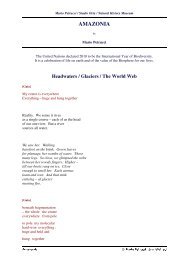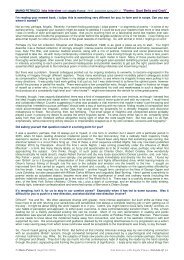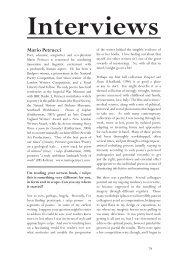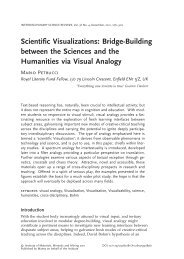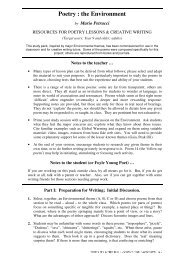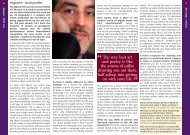Figure 1a Venn Analogy ('overlap' of ideas, theories ... - Mario Petrucci
Figure 1a Venn Analogy ('overlap' of ideas, theories ... - Mario Petrucci
Figure 1a Venn Analogy ('overlap' of ideas, theories ... - Mario Petrucci
Create successful ePaper yourself
Turn your PDF publications into a flip-book with our unique Google optimized e-Paper software.
<strong>Figure</strong> <strong>1a</strong><br />
<strong>Venn</strong> <strong>Analogy</strong><br />
(‘overlap’ <strong>of</strong> <strong>ideas</strong>, <strong>theories</strong>, etc. in conceptual space)<br />
A<br />
B<br />
C<br />
…. in 2D<br />
…. etc.<br />
THEORY<br />
‘D’<br />
THEORY ‘B’<br />
VISUALIZATION<br />
‘A’<br />
e.g. Inter / Intra Continuum<br />
( its set <strong>of</strong> concepts<br />
& associations )<br />
e.g. Structuralism<br />
MODEL ‘C’<br />
e.g. Jakobson<br />
…. = 3-dimensional<br />
Visualization<br />
© <strong>Mario</strong> <strong>Petrucci</strong> 2009
<strong>Figure</strong> 1b<br />
Extension <strong>of</strong> <strong>Venn</strong> diagram analogy to multi-dimensional space<br />
….<br />
all contingent in<br />
n dimensions<br />
… + others<br />
<br />
= the ‘WHOLE EXPERIENCE’<br />
<strong>of</strong> the TEXT<br />
© <strong>Mario</strong> <strong>Petrucci</strong> 2009
<strong>Figure</strong> 2<br />
The Spectrum <strong>Analogy</strong> for Intertextuality<br />
Primary Metaphor : scanning the textual ‘continuum’<br />
TEXTS are : • NOT ‘determined’ points on the line<br />
PHONIC<br />
NEUROLOGY ?<br />
(+ aural evolution)<br />
… COOING,<br />
‘SONIC CARESS’<br />
WHITE NOISE ?<br />
… ONOMATOPOEIA<br />
Some sonic effects <strong>of</strong><br />
CUT–UP POEMS here ?<br />
SOUND POETRY<br />
(e.g. Bob Cobbing)<br />
‘PHATIC’ effects<br />
TONE<br />
…. ALLUSIONS<br />
….. RHYTHMIC /<br />
METRIC<br />
similarity …..<br />
… ALLITERATION etc.<br />
DICTION …..<br />
• complex MAPPINGS / PROFILES along axis<br />
PASTICHE<br />
PARODY<br />
CUT–UPS ?<br />
(Deconstruction, Tzara…)<br />
funny word ?<br />
‘REPRODUCTION’<br />
PLAGIARISM<br />
REPRINTS /<br />
VERBATIM QUOTES<br />
Red curve gauges<br />
each textual<br />
‘RESONANCE’<br />
IN CONTEXT<br />
INTRA-TEXTUALITY<br />
IMPLICIT<br />
INTERTEXTUALITY<br />
EXPLICIT<br />
INTERTEXTUALITY<br />
VERY SHORT WAVELENGTHS<br />
SMALL WAVELENGTHS<br />
LONG WAVELENGTHS<br />
(‘Microscopic’)<br />
(‘Intermediate’)<br />
(‘Macroscopic’)<br />
Unconscious …<br />
effects hidden or ‘absorbed’<br />
into the process<br />
Covert …<br />
effects backgrounded<br />
Conscious …<br />
effects foregrounded<br />
© <strong>Mario</strong> <strong>Petrucci</strong> 2009
<strong>Figure</strong> 3<br />
Crosstalk <strong>Analogy</strong> for (Mis-) Translation<br />
1<br />
2 ?<br />
T<br />
RANSLATION ?<br />
=<br />
?<br />
• ‘Signal’ (i.e. text) passes from 1 st into 2 nd (similar) medium: i.e. from source to target language<br />
• Subsequent propagation then depends on 2 nd medium, with its different grammar, cultural references, etc.<br />
• Receiver 2 hears distorted version <strong>of</strong> 1<br />
… to what extent do linguistic media & their processes correspond (across cultures / languages) ?<br />
© <strong>Mario</strong> <strong>Petrucci</strong> 2009
<strong>Figure</strong> 4 ADAPTATION /<br />
ANALOGY for the evolving perception <strong>of</strong> an author / text<br />
NEW ENVIRONMENTAL CONDITIONS<br />
[e.g. fresh literary theory,<br />
wider cultural shifts, etc.]<br />
slight shift<br />
?<br />
???<br />
radical revision<br />
ADAPTATION / VARIATION<br />
COMPLEX ‘FAMILY LIKENESS’ :<br />
smooth / subtle changes in Reception<br />
MUTATION<br />
Deep reassessment :<br />
text / author perceived very differently<br />
Both types <strong>of</strong> change suggest / assume a complexlyresponsive,<br />
flexible, incremental Essentialism<br />
© <strong>Mario</strong> <strong>Petrucci</strong> 2009
<strong>Figure</strong> 5<br />
Chaos Theory <strong>Analogy</strong> for Textual Reception<br />
… like TEXT ?<br />
… like CONTEXT,<br />
INTERTEXT, etc. ?<br />
Is this process like weather? i.e. …<br />
• subject to (complex) laws<br />
• vast number <strong>of</strong> input variables<br />
• immensely sensitive to initial conditions<br />
• outcomes indeterminable<br />
• details impossible to nail down – but broad<br />
patterns may be predictable in short term<br />
TEXTS are ● resilient but susceptible systems<br />
● subject to multiple influences<br />
● unstable … in constant flux<br />
?<br />
… like RECEPTION ?<br />
© <strong>Mario</strong> <strong>Petrucci</strong> 2009
<strong>Figure</strong> 6<br />
The FAN <strong>of</strong><br />
RECEPTION<br />
( ADVANCED ANALOGY /<br />
HYPOTHESIS )<br />
TEXT<br />
RECEPTION <strong>of</strong> TEXT<br />
according to this FUNCTION<br />
GOLDEN<br />
AGE<br />
POUND’S<br />
‘ABC’<br />
‘AESTHETIC<br />
FASCISM’<br />
INTERTEXTUALITY<br />
CANONICITY<br />
RHYTHM<br />
METRE<br />
DOGGEREL<br />
SONIC<br />
RECOGNITION<br />
INTRA- ?<br />
NESCIENCE<br />
PRE-LINGUAL<br />
ORIGINALITY ?<br />
= INTERACTIVE<br />
FUNCTIONS<br />
etc.<br />
SEMIOTICS<br />
NOT ‘PURE FILTERS’ but :<br />
Cross-linked,<br />
Receiver- & Time-dependent,<br />
Resonant functions<br />
RECEPTION<br />
‘FEEDBACK’<br />
© <strong>Mario</strong> <strong>Petrucci</strong> 2009
<strong>Figure</strong> 7<br />
TRANSLATION ….<br />
( ANALOGY )<br />
Input<br />
... as a FILTER<br />
F<br />
Output<br />
(a) INPUT<br />
[original text]<br />
Spectrum below represents one set <strong>of</strong> characteristics in the source text<br />
(here, certain aspects <strong>of</strong> its ‘Intertextuality’) … this is ‘INPUT’ 1<br />
INTRA IMPLICIT EXPLICIT<br />
… other ways <strong>of</strong> characterising/ describing the text exist<br />
(giving a ‘fan’ <strong>of</strong> possible input spectra: 2, 3, etc.…)<br />
© <strong>Mario</strong> <strong>Petrucci</strong> 2009
(b) Example <strong>of</strong> FILTER characteristics in ‘free’ translation …<br />
… this ‘response spectrum’ to be applied to (laid over) the ‘source text spectrum’ in (a)<br />
2<br />
3<br />
1<br />
‘TRANSLATOR RESPONSE’ approach:<br />
i.e. a ‘take’ on the original,<br />
using original as ‘spur’<br />
= ‘Free’ or Distorted ?<br />
= STRONG TRANSLATOR COMPONENTS<br />
© <strong>Mario</strong> <strong>Petrucci</strong> 2009
<strong>Figure</strong> 8 The ‘13 WAYS’ :<br />
BUILDING AN ARGUMENT / LOGICAL STRUCTURE<br />
CORE STATEMENT C.S.<br />
1 2<br />
THEMES T1 T2 T3<br />
IDEA<br />
3a<br />
POINTS<br />
CORE STATEMENT<br />
X<br />
4 5<br />
Y<br />
Opposition<br />
3b<br />
DUMB-BELL [Thesis / Anti-thesis Synthesis]<br />
CARTWHEEL<br />
[ = themeless Core Statement?]<br />
X<br />
U U U U U<br />
U U U<br />
U<br />
U<br />
Y<br />
Connection<br />
‘Synapse<br />
Variation’<br />
STAIRCASE / LANDINGS<br />
[Stage by Stage or General Drift]<br />
6 7<br />
SPECTRAL ANALYSIS<br />
[Degrees / Measures / Extents]<br />
THEORY / HYPOTHESIS / IDEA<br />
8 9<br />
OBSERVATIONS<br />
?<br />
FEEDBACK<br />
LUDO<br />
[Closely-argued (linear)]<br />
CEMENTING<br />
[Relationships]<br />
VENN APPROACH<br />
[Similarities / Differences]<br />
SIGNIFICANCES<br />
CONCLUSIONS<br />
SEDIMENTATION<br />
[Sifting / Trickle-Down / Percolation]<br />
10<br />
X X<br />
X X<br />
X X<br />
X X<br />
11 12<br />
13<br />
X<br />
X<br />
CONSTELLATION-MAKING<br />
[Patterns / Loose Groups]<br />
X<br />
X<br />
X<br />
X<br />
X<br />
X<br />
X<br />
PYRAMID<br />
[Hierarchies]<br />
SWEEPING<br />
[Make clear by elimination]<br />
BRICK-WALL<br />
[All possibilities in a limited range]<br />
… etc. + ADAPTATIONS & +
<strong>Figure</strong> 9<br />
VISUALIZATIONS and THE ANALOGY-MAKING PROCESS<br />
(a hypothesis)<br />
true / existing<br />
(in this case, scientific)<br />
Source Visualization<br />
Deployed in analogy<br />
Visual <strong>Analogy</strong><br />
for target subject<br />
(= trial ‘analogic’ Visualization)<br />
SOURCE SUBJECT<br />
(e.g. bar magnets)<br />
Conceptual mis-/match ?<br />
true<br />
Target Visualization<br />
(if known or possible)<br />
© <strong>Mario</strong> <strong>Petrucci</strong> 2009<br />
TARGET SUBJECT


